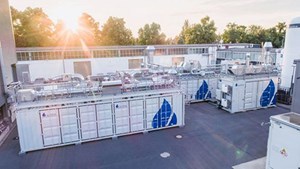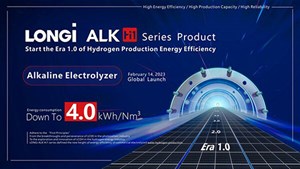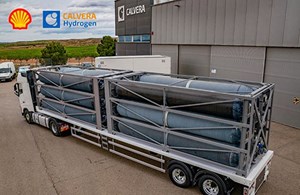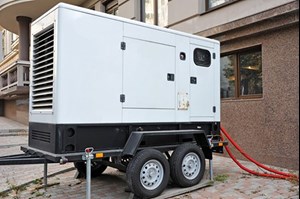Articles
H2Tech: Technology Spotlight
T. CAMPBELL, Managing Editor
H2 EQUIPMENT
H2scan launches HyView Display to advance transformer and battery room H2 safety solutions
H2scan has launched HyView, an industrialized display to complement its Gen 5 sensor products to meet a broad range of applications. HyView is a hardened display that can consolidate data from multiple hydrogen (H2) sensors and is available in explosion-proof and National Electrical Manufacturer Association (NEMA) ratings.
HyView pairs with H2scan’s next-generation sensing technology to provide local indication of H2 and oil temperature data in transformer applications and H2 concentration levels in area monitoring applications. The product includes an alarm output, which allows customers to easily wire alarms into their supervisory control and data acquisition systems, data center infrastructure management systems, network operations centers and other monitoring systems that accept digital outputs. HyView connects with up to four GRIDSCAN 5000 or HY-ALERTA 5021 sensors and enables indicating and alarming for real-time monitoring.
HyView includes a dual-line display easily scaled for 4-20 mA analog output values, and its wide viewing angle display and through-glass buttons create a simple and convenient user experience. These buttons allow the HyView to be programmed and operated through the front panel, thus eliminating the need to remove the cover in hazardous areas.
Battery room operations are made safer by the HyView product when combined with H2scan’s HY-ALERTA 5021 H2 area monitor. HY-ALERTA meets all code requirements, including continuous monitoring to keep H2 below a 25% lower flammable limit, communications to activate exhaust fans and Modbus communication to meet annunciation requirements.
The GRIDCAN 5000 and HY-ALERTA 5021 sensors eliminate false positives by detecting only H2. The sensor lifecycle is 10 yr−15 yr (avoiding expensive replacement costs) and auto-calibrates, reducing maintenance costs.
Evonik starts up new production plant for H2 extraction in Austria
Evonik has started a new hollow-fiber spinning plant to produce gas separation membranes in Schörfling am Attersee in Austria. The new production capacity enables the company to meet ongoing strong demand for SEPURAN membranes in biogas, nitrogen, H2 and natural gas applications. Evonik has invested a low double-digit €MM amount in the new plant and created around 30 new jobs in Schörfling.
In the new production plant, several steps process a high-performance polymer into fine hollow fibers that are at the heart of Evonik’s SEPURAN membrane technology. The specialty chemicals company draws on its many years of expertise in polymer chemistry and adjusts key membrane properties already at the development stage of the base material—a high-performance polymer—to produce particularly selective and robust membranes that can withstand extreme pressures and temperatures.
Evonik already relies entirely on renewable energies for membrane production in Schörfling am Attersee. Green electricity from wind, water and biomass has been a key energy source for the production facility for years. Since the beginning of 2022, the specialty chemicals company has met 100% of its gas requirements with biomethane from regional production. By switching to an environmentally friendly energy supply, Evonik is reducing its direct CO2 emissions in Austria by approximately 4,000 metric tpy.
SEPURAN Noble membranes extract the H2 transported through natural gas pipelines from the methane/H2 gas mixture at specific H2 gas withdrawal points. SEPURAN NG membranes enable efficient natural gas processing from sources with high CO2 concentrations. SEPURAN Green membranes enable efficient biogas processing from organic and circular sources.
H2 PRODUCTION
Sunfire successfully commissions high-temperature electrolyzer
Renewable fuels and chemical products produced from renewable electricity and CO2 are considered promising climate-neutral solutions for the chemical and mobility industries. The Dresden-based H2 company, Sunfire, has developed a new co-electrolysis technology to produce these raw materials.
Sunfire’s high-temperature co-electrolysis plant is an important part of the research project in its second funding phase. The company’s plant factory acceptance test has been completed.
As a result, Sunfire put its new generation of co-electrolysis into operation for the first time. The unique feature of this technology is the process in which synthesis gas—a mixture of H2 and carbon monoxide—is produced in one step using renewable electricity from water, steam and CO2. The whole process takes place at high operating temperatures of up to 850°C.
Within the final acceptance test, an output of up to 220 kW with an electrical efficiency of more than 85% low heating value was achieved, representing a significant increase compared to the proof-of-concept system of the first project phase (10 kW). Sunfire relied on significant operational experience from the completed SynLink research project funded by the German Federal Ministry of Economics and Climate Protection. Sunfire developed and validated a co-electrolysis module in the 150-kW size class as part of the project.
LONGi Hydrogen launches new generation of alkaline electrolyzer
LONGi Hydrogen, a wholly-owned subsidiary of China's solar giant LONGi Green Energy Technology, has launched its new generation of alkaline electrolyzed water H2 production equipment, ALK Hi1, in Beijing, continuously exploring the lowest of energy consumption and redefining the height of energy efficiency.
Based on the rich experience in the photovoltaic field, LONGi found that—like the levelized cost of photovoltaic energy—the core path is to reduce the electricity consumption of H2 production units for the same electricity consumption to produce more H2. The lower the levelized cost of H2 (LCOH) is, the more cost-efficient the green H2.
Electricity price and energy consumption per unit of H2 production are the two variables that contribute to the highest sensitivity of LCOH. The full-load direct current (DC) power consumption of ALK Hi1 can be as low as 4.3 kWh/Nm³. It is even lower for ALK Hi1 Plus, down to 4.1 kWh/Nm³, to adapt to H2 production scenarios demanding higher utilization hours. It even hits 4.0 kWh/Nm³ when the current density is 2500 A/m2.
Research also shows that full-load DC power consumption of the global electrolyzed water H2 production industry—alkaline water H2 production technology and proton exchange membrane electrolysis—is in the range of 4.5-4.6 kWh/Nm³.
So far, LONGi ALK Hi1 series products have passed empirical testing, and its performance has been certified by third-party authorities, such as Det Norske Veritas and DEKRA Testing and Certification, and measured following the national standard of GB-32311-2015. LONGi ALK Hi1 series products are rated to have the level 1 energy efficiency of H2 production system.
LONGi ALK Hi1 series products have the characteristics of high efficiency and high production capacity, which means a reduction of DC power consumption by more than 10%, and the LCOH of H2 production in different scenarios will be greatly cut down. For 0.1 kWh/Nm³'s reduction in H2 production DC power consumption, depending on the number of system utilization hours, H2 LCOH can be reduced by 1.8%−2.2%, equivalent to a reduction of the initial investment of H2 production equipment by 10%–25%. In the context of carbon peaking and neutrality, the energy development trend will gradually shift from carbon-based to silicon-based energy and then to H2 energy.
H2 APPLICATIONS INNOVATIONS
INEOS plans low-carbon H2-powered cracker in Europe
INEOS Olefins Belgium’s new cracker in Antwerp will have the lowest carbon footprint of all European crackers, five times better than the worst in Europe and two times better than the best, according to the company. The plant is designed to use low-carbon H2, and the cracker will have a zero-carbon footprint as soon as enough H2 becomes available.
INEOS has raised €3.5 B to support the construction and operation of the cracker, and this is the largest investment in the European chemical sector for a generation. The plant can also operate entirely with low-carbon H2 and has room for a carbon capture facility and future electric furnaces.
Supported by 21 commercial banks, the deal validates the strong commercial rationale of the project and its leading environmental characteristics. The debt will be drawn in stages to support the spending profile of the project through to completion.
The cracker will produce ethylene, a vital raw material for a wide range of products essential to daily lives, from insulation to lightweight vehicles, plastics for medical, healthcare and food hygiene, and technology for renewable energy.
H2 STORAGE AND TRANSPORTATION APPLICATIONS
Calvera Hydrogen develops H2 transport tube trailer model for Shell Hydrogen
Calvera Hydrogen has developed a H2 tube trailer model at its facilities in Zaragoza, Spain. The equipment is designed to transport 1 t (2,270 lb) of H2 on U.S. roads and more than 1.3 t (2,870 lb) on EU roads (due to the different road weight regulations of each region), with a working pressure of 517 bar (7,500 psi). This makes it the highest-operating pressure tube trailer in the international market. It is made of state-of-the-art carbon fiber and is 45-ft long. This project has been developed for Shell Hydrogen and will be used to service Shell’s H2 refueling stations globally.
The companies have been working together for more than 2 yr on this project's engineering and technological development, which will take its first steps in the U.S. and Germany. Due to a framework agreement between the two companies, new units of this tube trailer model are being developed to cover the H2 transport needs of Shell’s refueling stations in the U.S., Europe and the UK.
The equipment is designed to optimize the capacity and pressure of the stored H2 and achieve maximum efficiency and cost savings in the dispatch of H2 in the H2 refueling stations. The tube trailer actuates through automatic valves at different pressure stages and performs the dual function of mobile and fixed smart storage.
This project stands out for the innovation and complexity of its design and has been conceived under the highest safety standards. It has a differential feature that makes it unique since it is approved to comply with regulations in the U.S. and Europe, which has been a challenge in the design and regulatory processes for its approval.
Loop Energy partners with Canadian Power Solutions provider to develop H2-electric gensets
Loop Energy, a designer and manufacturer of H2 fuel cell solutions, has delivered the first three fuel cell systems to H2 Portable, a Canadian developer of H2-electric mobile power solutions. The fuel cells will be integrated into H2-electric gensets designed to provide clean, reliable, on-demand power to movie sets, construction sites and other locations with limited grid power access.
Located in Chilliwack, British Columbia, Canada, H2 Portable is focused on developing market opportunities for its next-generation H2-electric gensets. H2 Portable has a strategic product development and manufacturing partnership with TYCROP Manufacturing, one of BC’s leading industrial manufacturing companies.
Following the delivery of the T505 (50-kW) fuel cell systems, the gensets are expected to begin field testing in 2023. H2 Portable and TYCROP will aim to scale production starting in 2024 to satisfy the growing demand for H2-electric power systems across industries in Canada and the U.S.
H2 Portable selected Loop Energy as its technology provider following a tender process, which highlighted the enhanced fuel efficiency of its fuel cells. H2 Portable can reduce its customers' operating costs by lowering fuel consumption. Loop Energy’s Global Technical Services team works alongside H2 Portable and TYCROP to optimize and commercially scale its technology.







